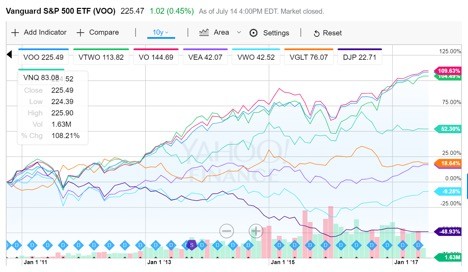
I met with a prospective client recently who had an account full of actively managed mutual funds. When I pointed out what they were paying in fees, some of which were buried in the statements and difficult to spot, I asked what they thought they got for those fees. “They’re diversifying our money well to avoid the big losses we experienced in 2008 again,” they said.
So we looked into that assumption. Upon closer inspection, we found somewhat less diversity than had been assumed. These funds had names that seemed different enough to allow someone outside the financial services industry to think that their money was in a diverse, recession-proof account. You’d see things like US Large Cap, Small and Mid Cap, International, Aggregate Bond, etc. Different names, different areas of the economy. Therefore, diversity. Right?
Maybe not.
Here’s a chart representing various asset class price patterns since 2010. On first glance, this may seem complicated. I’ll break it down below.
The three funds at the top (the red, darker blue, and green) are US Large, Small, and Mid cap stocks (as represented by Vanguard’s exchange traded funds in those categories). Next in light green is real estate. That’s followed by aggregate bonds [color] developed foreign country stocks (orange), emerging foreign stocks (light purple) and last, and least, are commodities (dark purple) with a near negative 50% return over that time period).
My point here is that most of the money in these mutual funds are in stocks and bonds, while a relatively small amount is in commodities like gold, oil, and wheat. This is known as home bias.
This home bias, once you’re looking for it, is easy to spot, and not something you want if you want true diversity in your investments.
As you can see in the chart above, domestic stocks have essentially mirrored each other. So, if your advisor follows this model or one like it—and most of them do—you have your money spread out over a group of funds like this.
But having lots of funds doesn’t mean you’re truly diversified because they’re all moving in the same direction. So when the next crisis arrives, all those funds will go down together.
To truly diversify, you have to put your money in things that will zig when the others are zagging. You have to be open to thinking outside the conventional wisdom that the rest of the herd is following. Rest assured, there is no safety in the herd.
We broke away from the herd in 2012. We can help you do the same.